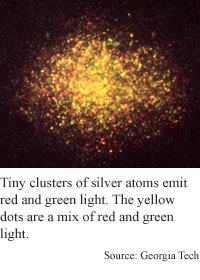
Silver shines red and green
By Kimberly Patch, Technology Research NewsSilver, in very small quantities, can act rather like a traffic light, a trait that could be used to store bits of information.
Researchers from the Georgia Institute of Technology are using the florescence characteristics of tiny clusters of silver atoms to gain red, green and shades of yellow that can be controlled, or rewritten, with a laser.
The researchers have figured out how to photochemically create very small clusters of silver atoms that emit light at room temperature. They've demonstrated a binary data storage prototype that simply uses light and the absence of light to store information.
The scheme has the potential to go beyond binary storage because the clusters can emit both red and green light, and clusters that emit both colors at nearly the same time produce mixes of the two colors that look yellow, said Robert Dickson, an assistant professor of chemistry at the Georgia Institute of Technology.
This is because as an organic molecule gains double bonds, the wavelengths of light it absorbs shift. As more silver atoms join a cluster, forming double bonds, "you get a shift to longer wavelengths. Different sizes and also potentially different geometries of a given cluster size will give different emission colors," said Dickson.
This scheme can potentially store a lot of information in a small space because it uses multiple colors and because the clusters, made up of only a few silver atoms, are so small.
The number of possible colors this scheme could produce depends on how many distinct mixes of yellow can be detected, said Dickson. "You could use it as a high-density data storage medium using shades of different colors to store more than one bit of information per data point," he said.
For instance, if a certain point has the potential to be one of four colors, those four colors could represent all the possible combinations of two bits: 00, 01, 10, and 11. In a similar manner, eight colors could store three bits of information and 16 colors four bits of information.
The tiny clusters could also eventually be used as biological labels whose florescence could be turned on and off with a laser, said Dickson. The clusters could be attached to certain types of cells, for example, which could then be tracked as they move through the body. "It's very early on. [The results show] potential for data storage [and] for potentially interesting biological labels that can turn on at a certain time," he said.
The researchers create the clusters by irradiating silver oxide, which changes it into clusters of a few silver atoms each plus silver peroxide. When blue light is shown on these silver nanoparticles, they fluoresce. Fluorescence occurs when an atom absorbs energy from light, which moves one of the atom's electrons to a higher energy level. When the electron relaxes back to a lower energy level, the atom releases the excess energy in the form of a photon.
The scheme can be used to rewrite information. "It allows you to generate florescence only in the areas that you've pre-illuminated, so you can write images to our samples," said Dickson.
The researchers are currently working on better controlling the florescence. "We are nailing down the mechanism for how these clusters change size and are produced... by doing very fundamental photophysical studies -- florescence absorption type measurements," said Dickson. Those studies are a precursor to designing materials optimized for data storage. "You want nice, properly sensitized particles that... will give us the behavior we want," he said.
A silver florescence data storage mechanism could be produced within a decade, said Dickson. Biological labeling using this method would likely take longer because it involves figuring out how to attach the clusters to proteins and put them inside living cells, said Dickson.
Dickson's research colleagues were Lynn A. Peyser, Amy E. Vinson and Andrew P. Bartko of Georgia Tech. They published the research in the January 8, 2001 issue of Applied Physics Letters. The research was funded by Georgia Tech.
Timeline: 10 years
Funding: University
TRN Categories: Semiconductors and Materials; Data Storage Technology
Story Type: News
Related Elements: Photo 1; Technical paper, "Photo Activated Florescence from Individual Silver Nanoclusters," Science, January 5, 2001.
Advertisements:
February 14, 2001
Page One
Quantum effect moves machine
Software speeds gene comparison
Agents learn from traveling salesman
Harder chips make more sensitive sensors
Silver atoms shine red and green

News:
Research News Roundup
Research Watch blog
Features:
View from the High Ground Q&A
How It Works
RSS Feeds:
News
Ad links:
Buy an ad link
| Advertisements:
|
 |
Ad links: Clear History
Buy an ad link
|
TRN
Newswire and Headline Feeds for Web sites
|
© Copyright Technology Research News, LLC 2000-2006. All rights reserved.